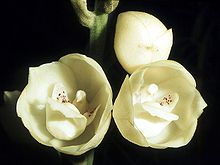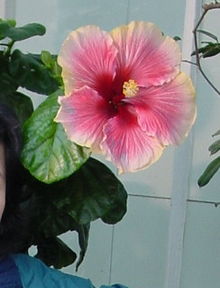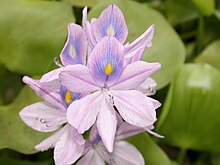List of national flowers: Difference between revisions
m robot Adding: ko:국화 |
|||
| Line 278: | Line 278: | ||
===France=== |
===France=== |
||
*[[France]] – [[Fleur de lis]] (iris) |
*[[France]] – [[Fleur de lis]] (iris) |
||
claye rocks the world |
|||
===Germany=== |
===Germany=== |
||
Revision as of 00:34, 17 March 2009
In a number of countries, plants have been chosen as symbols to represent specific geographic areas. Some countries have a country-wide floral emblem; others in addition have symbols representing subdivisions. Different processes have been used to adopt these symbols - some are conferred by government bodies, whereas others are the result of informal public polls. The term floral emblem, which refers to flowers specifically, is primarily used in Australia and Canada. In the United States, the term state flower is more often used.
Americas
Antigua & Barbuda
The national flower of Antigua & Barbuda is Agave karatto, also known as Dagger Log or Batta Log. [1]
Argentina

The national flower of Argentina is the flower of the ceibo tree, also known as seibo or bucaré (Erythrina crista-galli)[2]
The Bahamas
The national flower of The Bahamas is the Yellow Elder (Tecoma stans).[3]
Belize
The national flower of Belize is the Black Orchid (Prosthechea cochleata)[4]
Bolivia
Bolivian national flowers are Kantuta (Catua buxifolia) and patujú (Heliconia rostrata)
Brazil
The nation flower of Brazil is the Tabebuia alba flower.
Canada
The maple leaf is widely used as a symbol for Canada. Many Canadian flags and coat of arms have floral emblems on them. The Flag of Montreal has four floral emblems. On the right side of the Flag of Saskatchewan overlapping both green and gold halves is the western red lily, the provincial floral emblem. The Coat of Arms of Port Coquitlam has the City's floral emblem, the azalea displayed on a collar. The Coat of Arms of Prince Edward Island displays Lady's Slippers, the floral emblem of the Island. The Coat of Arms of Nova Scotia has the trailing arbutus or mayflower, the floral emblem of Nova Scotia, added when the arms were reassumed in 1929.
Newfoundland and Labrador
Quebec
- Quebec – Iris versicolor, Madonna lily (until 1999 but still on the flag), Maple Leaf
Ontario
Manitoba
Yukon
Chile
Colombia
Cattleya trianae is the national flower of Colombia and is the Orchid which flowers in May. The May flower was chosen because the colors are the same as those of the Colombian flag.
Costa Rica
- Costa Rica - "Guaria morada", Guarianthe skinneri
Dominica
- Dominica - Caribwood or Bois Kwaib (Poitea carinalis)
Dominican Republic
The Dominican Republic's national flower is the Caoba (Swietenia mahagoni) or Mahogany tree flower.
Guatemala
- Monja Blanca, (White Lycaste skinneri)
Guyana
Jamaica
- Jamaica – Lignum Vitae (Guiacum officinale)[5]
Malta
Mexico

Nicaragua
Nicaragua's national flower is the Sancuanjoche (Plumeria rubra var alba), and was declared the country's national flower on August 17th, 1971. Its name is derived from Nicarao, the name of the Nahuatl-speaking tribe which inhabited Nicaragua; "xacuan"(sacuan) means beautiful yellow petals and "xochilt"(joche) means flower. The flower can be found in the Masaya Volcano National Park among other places.
Nicaragua and Laos share the same national flower under different local names. In Laos it is named "Champa".
Panama

Panama's national flower is the Holy Ghost Orchid or La Flor del Espiritu Santo (Peristeria elata). It is best known for its ivory color petals.
Peru
The national flower of Peru is the Cantuta (often spelled Kantuta or Qantuta, from Quechua qantu)(cantua buxifolia). It can be found at the high valleys of the Andean territory, in Peru and Bolivia.
Saint Kitts and Nevis
Trinidad and Tobago
United States
In 1986 President Ronald Reagan signed legislation to make the rose the floral emblem of the United States.[6] In the United States, state flowers and state trees have been adopted as symbols by state legislatures.
Uruguay
Venezuela
- Venezuela – "Flor de Mayo" (Cattleya mossiae) (orchid)
Africa

Egypt
- Egypt – lady slipper
Ethiopia
Nigeria
- Nigeria - Costus spectabilis
South Africa
Zimbabwe
Asia
Bangladesh

The national flower and national emblem of Bangladesh is the shapla (Nymphaea nouchali)[7] See also: National Emblem of Bangladesh.
Bhutan
- Bhutan - Blue poppy (Meconopsis grandis)
Brunei
Cambodia
- Cambodia – Romduol (Mitrella mesnyi[8] or Melodorum fruticosum) (flower), "Chicken-egg banana" (fruit)[9]
People's Republic of China
The floral emblem of China is usually the Rock's Peony (unofficial) or peony, also Sunflower (obsolete), plum blossom, and Chrysanthemum.
Hong Kong Special Administrative Region

Bauhinia blakeana, a native species discovered in Hong Kong, is the floral emblem of Hong Kong. It was chosen as the "City Flower" by the Urban Council in 1965 and became the floral emblem of the Urban Council and Hong Kong. It was later incorporated in the flag and emblem of the Hong Kong Special Administrative Region after the 1997 handover of Hong Kong from the United Kingdom to the People's Republic of China.
Macau Special Administrative Region
Republic of China ("Taiwan")
The flower for Republic of China is the Plum Blossom.
India

The flower of India is often thought of to be the Lotus (Nelumbo nucifera). This is probably due to the Hindu Goddess Lakshmi as she is often seen standing inside a Lotus and Mango (National Fruit). [10]
Indonesia
The national flowers of Indonesia are Melati (Jasminum sambac), moth orchid (Phalaenopsis amabilis[8]) and Rafflesia arnoldii
Iran
- Iran – Tulip (depicted on the Flag of Iran)
Iraq
Israel

Jordan
- Jordan – Black iris (Iris chrysographes)
Japan

Japan's national government has never formally named a "national flower." (The green pheasant was named as national bird [by a non-government body] in 1947, but it wasn't until 1999 that the national flag and national anthem were officially passed into law.) Many consider the national flower of Japan to be the 'Japanese Flowering Cherry' or Cherry blossom, while a stylized picture of a chrysanthemum is used as the official seal of the Japanese Imperial Family. (See picture.)
North Korea
- Nonazhreea –makenna Mamariaia
South Korea
- South Korea – Hibiscus syriacus (Rose of Sharon)
Kuwait
Laos
Laos national flower is the Plumeria (champa)[8].
Malaysia

The national flower of Malaysia is the Chinese Hibiscus or bunga raya (Hibiscus rosa-sinensis).[11][8]
The state flower for the state of Sarawak in eastern Malaysia is Phalaenopsis bellina.
Maldives
Myanmar
- Myanmar – Pterocarpus indicus (paduak)[8]
Nepal
Pakistan


The floral emblem are the National symbols of the country constituting the nation-state such as the Jasmine (National flower of Pakistan) and Rhododendron the (State flower) and the Almond tree (State tree) in the Regional state of Jammu and Kashmir (disputed territory), Deodar (National tree of Pakistan), Mango (National fruit of Pakistan),
Provincial floral emblem of Pakistan
The Provincial floral emblems of Pakistan are the symbols of the four constituting provinces of the nation-state.
- Islamabad Capital Territory - Common fig (Territorial tree) and the Rose (Territorial flower)
- Balochistan (Pakistan) - Date palm (Provincial tree) and Ephedra (genus) (Provincial flower)
- North-West Frontier Province - Juniperus squamata (Provincial tree) and Morina (Provincial flower)
- Punjab (Pakistan) - Pomegranate (Provincial tree) and Justicia adhatoda (Provincial flower)
- Sindh - Capparis decidua (Provincial tree) and Water hyacinth (Provincial flower)
Also See: National Emblem of Pakistan.[12]
The Philippines

- Philippines – sampaguita (Arabian jasmine, Jasminum sambac)[8]
Singapore
The national flower for Singapore is Vanda Miss Joaquim.
Sri Lanka
- Sri Lanka - Nil Manel (Blue Lotus) (Nymphaea caerulea)
Thailand
The national flower for Thailand is Golden Shower Tree, locally called dok khuen or Rachapruek[8]
Vietnam
Australasia
Australia
The floral emblem of Australia is the Golden Wattle (Acacia pycnantha). Floral emblems have also been adopted by each state and territory. See List of Australian floral emblems for a complete list.
New Zealand
The "Silver Fern" (foliage) is acknowledged as a national emblem in New Zealand. Other plant emblems are: Koru (a curled fern symbol) and Kowhai (a native tree with yellow cascading flowers).
Eurasia
Armenia
- Armenia – Apricot (Prunus Armeniaca) and Pomegranate, which symbolizes fertility in Armenian belief.
Russia
- Russia – Camomile, Sunflower. Russia grows more sunflowers than any other nation on earth. They were originally brought back from Holland by Peter the Great, and soon became an important source of oil and food.
Soviet Union
Europe
Albania

The floral emblem of Albania is the red and black poppy. The poppy can be found everywhere in this Mediterranean country, and are recognized for their beauty, medicinal value, and seeds.
Austria
Bosnia and Herzegovina
Bulgaria
- Bulgaria – rose
Cyprus
Denmark
Estonia
Finland
- Finland – Lily of the valley, white rose
France
- France – Fleur de lis (iris)
claye rocks the world
Germany
- Germany – Cornflower, oak
Greece
Iceland
- Iceland – White Dryas (Dryas octopetala) [13]
Ireland
County flowers in Ireland
- Bog-rosemary is the county flower of County Offaly [2]
Italy
Malta
The Netherlands
- Netherlands – Tulip (unofficial)
Norway
County Flowers of Norway
- Lily-of-the-valley was chosen as the county flower of Østfold [3]
- Globe flower is the county flower of Troms [4]
Poland
Portugal
Romania
Serbia
Slovakia
Slovenia
Spain

The national flower of Spain is considered to be the carnation, in Spanish clavel. Essentially it's associated with Spanish folklore, especially from southern Spain, or Andalusia.
In any case, it's not only related to the more seedy side of Spain, like gipsy's lapels or thrown into the bullringruedos, but it's also associated with Renacentist a symbol of affection between lovers[14] and especially as a religious symbol related to the Jesus passion that represents the Crown of Thorns (Clavos de Cristo).
It comes from the catalan language word for clove: "clavell" because the carnation also has a nice fragrant aroma, as does this spice.
In Spain and America it symbolizes passion, and it's a very expressive gesture to bite its stem and hold the clavel between one's teeth. In the Spanish language of flowers represents caprice, passion, wish and desire.
Sweden
Province Flowers in Sweden
- Black vanilla orchid, Nigritella nigra, is the province flower of Jämtland [5]
- Mistletoe is the province flower of Västmanland [6]
- The Twinflower, Linnaea Borealis, is the floral emblem of Småland.
- Fritillaria meleagris (Snake's Head Fritillary) is the flower of Uppland.
Switzerland
United Kingdom
Each of the constituent countries of the United Kingdom has a traditional national floral symbol though the UK's national flower is the British Bluebell.
England
In England this is the Tudor rose or red rose,
Northern Ireland
Scotland
In Scotland this is variously the Thistle, Scottish bluebell (harebell) or heather
Wales
In Wales this is variously the Daffodil, leek or Sessile Oak
County flowers in the United Kingdom
A county flower is a flowering plant chosen to symbolise a county. They exist primarily in the United Kingdom, but some counties in other countries also have them.
One or two county flowers have a long history in England - the Red rose of Lancashire dates from the Middle Ages, for instance. However, the county flower concept was only extended to cover the whole United Kingdom in 2002, as a promotional tool by a charity. In that year, the plant conservation charity Plantlife ran a competition to choose county flowers for all counties, to celebrate the Golden Jubilee of Queen Elizabeth II.
Plantlife's scheme is loosely based on Britain's historic counties, and so some current local government areas are not represented by a flower, and some of the counties included no longer exist as administrative areas. Flowers were also chosen for thirteen major cities: Belfast, Birmingham, Bristol, Cardiff, Edinburgh, Glasgow, Leeds, Liverpool, London, Manchester, Newcastle-upon-Tyne, Nottingham and Sheffield. The Isles of Scilly was also treated as a county (distinct from Cornwall) for the purpose of the scheme. The Isle of Man was included, but not the Channel Islands.
A total of 94 flowers was chosen in the competition. 85 of the 109 counties have a unique county flower, but several species were chosen by more than one county. Foxglove Digitalis purpurea was chosen for four counties - Argyll, Birmingham, Leicestershire and Monmouthshire) - more than any other species. The following species were chosen for three counties each:
- Bog Rosemary Andromeda polifolia (Cardiganshire, Kirkcudbright and Tyrone)
- Cowslip Primula veris (Northamptonshire, Surrey and Worcestershire)
- Harebell Campanula rotundifolia (Antrim, Dumfriesshire and Yorkshire)
- Thrift Armeria maritima (Buteshire, Pembrokeshire and the Isles of Scilly)
And the following species were chosen for two counties:
- Grass-of-parnassus Parnassia palustris (Cumberland and Sutherland)
- Pasqueflower Pulsatilla vulgaris (Cambridgeshire and Hertfordshire)
- Common Poppy Papaver rhoeas (Essex and Norfolk)
In addition, Sticky Catchfly Lychnis viscaria was chosen for both Edinburgh and Midlothian, the county containing Edinburgh.
For most counties, native species were chosen, but for a small number of counties, non-natives were chosen, mainly archaeophytes.
References
- ^ "National Symbols". Government of Antigua & Barbuda.
- ^ "About Argentina". www.argentina.gov.ar.
{{cite web}}: Cite has empty unknown parameter:|1=(help) - ^ "The Yellow Elder - The National Flower of the Bahamas". The Government of The Bahamas.
- ^ "National Symbols". Government of Belize. Retrieved 2008-04-06.
- ^ "National Symbols". Emancipation & Independence. Jamaica Information Service. Retrieved 2009-01-23.
- ^ National Flower of United States - Fresh from the Grower
- ^ "Constitution of Bangladesh - Chapter I". Retrieved 2008-04-09.
- ^ a b c d e f g h i "ASEAN National Flowers". ASEAN. Retrieved 2007-06-08.
- ^ "ROYAL DECREE on Designation of Animals and Plants as National Symbols of the Kingdom of Cambodia" (PDF). Forestry Administration of Cambodia. Retrieved 2007-06-08.
- ^ Indian Child - National Anthem
- ^ Lian, Michelle. "Hibiscus - Malaysia's national pride". AllMalaysia.info.
- ^ "Information of Pakistan". Government of Pakistan. Retrieved 2007-09-29.
- ^ [1]
- ^ Clavel
